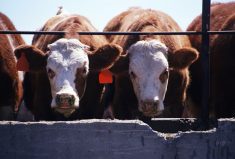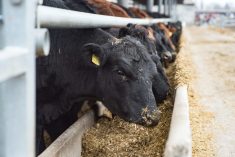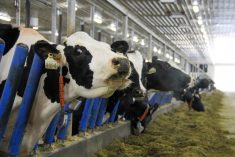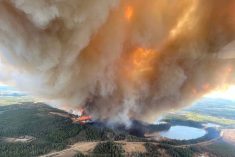While a new United Nations report on climate change and land calls for “rebalancing diets,” the policy paths it seeks are a good fit for beef cattle ranching as Canadians know it, the Canadian Cattlemen’s Association says.
Responding Thursday to the report from the UN’s Intergovernmental Panel on Climate Change (IPCC), the CCA said Canada’s beef production system is an “excellent example” of what the report described as a “resilient, sustainable and low-GHG (greenhouse gas) emission system.”
Specifically, the IPCC said, “Balanced diets, featuring plant-based foods, such as those based on coarse grains, legumes, fruits and vegetables, nuts and seeds, and animal-sourced food produced in resilient, sustainable and low-GHG emission systems, present major opportunities for adaption and mitigation while generating significant co-benefits in terms of human health.”
Read Also

U.S. livestock: Cattle strength continues
Cattle futures on the Chicago Mercantile Exchange were stronger on Friday, hitting fresh highs to end the week.
The CCA said research shows Canadian beef “has one of the lowest (GHG) footprints in the world, accounting for only 0.04 per cent of the world’s (GHG) emissions.”
In Canada alone, the CCA said, the beef industry chalks up 2.4 per cent of the country’s total GHG footprint while contributing $33 billion to the Canadian economy and storing “substantial amounts of carbon” in managed rangelands.
Canadian beef cattle also “help to preserve one of the world’s most endangered ecosystems,” the CCA said, quoting the World Wildlife Fund as saying half of the northern Great Plains have already been lost to cultivated agriculture.
The beef sector preserves wildlife habitats under threat from cultivation through “well-managed grazing” on uncultivated land, housing at-risk species such as the swift fox, sage grouse and monarch butterfly, the CCA added.
Land managed by beef producers provides habitat capacity for 68 per cent of wildlife on only 33 per cent of total agricultural area in Canada, the CCA added.
The IPCC report also calls for action on conservation, including protecting remaining grasslands from crop agriculture and restoring native grasslands to provide habitat and increase carbon storage, the CCA said.
‘Greater consumption’
That said, the IPCC report also notes “food system emissions are growing globally due to increasing population, income, and demand for animal-sourced products. Diets are changing on average toward greater consumption of animal-based foods, vegetable oils and sugar/sweeteners, with GHG emissions increasing due to greater amounts of animal-based products in diets.”
The report suggests that by 2050, “dietary changes” could free up several million square kilometres of land and provide “technical mitigation potential” of 0.7 to eight gigatonnes of carbon dioxide equivalent per year “relative to business as usual projections.”
“Consumers certainly have the right to choose the food they eat,” the CCA said Thursday in response. “However, reducing meat consumption is not a solution to climate change. Research continues to show that reducing food waste will have a far larger impact on mitigating climate change.”
In Canada alone, the CCA said, “the estimate is that consumers waste 40 per cent of their food, much of which has been refrigerated and transported for great distances to get here.”
The IPCC report concurs that reducing food loss and waste will also help lower GHG emissions and “contribute to adaptation through reduction in the land area needed for food production.”
Toward that end, it lists technical options such as improving harvesting techniques, on-farm storage, infrastructure, transport, packaging, retail and education.
However, the report also cites projections out to 2050 from the UN Food and Agriculture Organization as showing “global-scale evidence that rebalancing diets is key to increasing the overall sustainability of food and agricultural systems worldwide.”
A 15 per cent reduction of animal products in the diets of high-income countries by 2050 would “contribute to containing the need to expand agricultural output due to upward global demographic trends,” the report said.
“Not only would GHG emissions and the pressure on land and water be significantly reduced but the potential for low-income countries to increase the intake of animal-based food, with beneficial nutritional outcomes, could be enhanced.”
‘Life cycle analysis’
In defense of ruminant livestock overall, the IPCC report also notes that “analyzing ruminant meat production is highly complex because of the extreme heterogeneity of production systems and due to the numerous products and services associated with ruminants.”
Often, the report notes, the cattle sector’s emissions are all allocated “only to human-edible meat and the boundaries are set only within the farm gate.”
But less than 50 per cent of slaughtered cattle weight is human-edible meat, the IPCC said, and one to 10 per cent is lost or incinerated, depending on a country’s rules around specified risk materials (SRMs) such as nervous system tissues.
The rest of the animal’s mass, the IPCC noted, provides inputs to “multiple” industries such as clothing, furniture, vehicle coating materials, biofuel, gelatin, soaps, cosmetics, pet foods, fertilizers and chemical and pharmaceutical industrial supplies.
In turn, the report said, “this makes ruminant meat production one of the most complex problems for LCA (life cycle analysis) in the food system.” — Glacier FarmMedia Network















